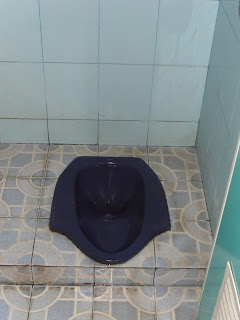Sekolah Dasar Kanisius Sorewajan is a Catholic Private school. The students consist of rural and urban students coming from low to middle social economic backgrounds. The school aims to provide good quality education based on Catholic principles. Students are expected to achieve academically, and be caring towards the environment and others.
The Principal- Suwardi has introduced many programs which focus on the whole child such as an extensive healthy eating program where children are involved in growing vegetables and cooking.
The ethos of the school is based on Christian values and on providing a community where children can achieve and learn skills. Many of the teachers are young and energetic.
The school has just been awarded a grant for computers and now has a computer lab. All classes are learning English and value their connection with the world through technology and language.
Extra curricular activities such are scouts, music, art and sport lessons are held on Friday. This is to ensure the focus of the school is not always on academics but also on life skills and enjoyment.
The physical layout of both Indonesian schools that I have visited has been similar from the furniture layout being in rows, to images of the Pancasila, presidents and a significant military representative. Another similarity, and trend, seems to be little teaching /learning support material on the classroom walls and teacher focused learning, however, this is where the similarities between the two Indonesian schools ended.
Students at this school had many more personal exercise books and additional text books. The students in the younger classes had multiple books; Matematika, Bahasa Inggris, Bahasa Indonesia, Illmu Pengetahuan Sosial, Pengetahun Alam and Pendidikan Keworganegaran. The year five class also had a number of resources that included multiple exercise books and text books. There was also evidence that resources were purchased to support arts activities such as pastel crayons for visual art and paddlepop sticks for design and construction.
The more experienced teachers in both schools practised simple strategies to keep students engaged as those observed in Australian schools; such as proximity, supporting learning by assisting individuals and making clear the expectations for the current task
Every school, whether from a state or private, Indonesian or Australian school as a individual teacher or a collective group of professionals we all have a ‘cita-cita’ or mission statement that communicates the importance of developing the ‘whole child.’
Bee- ORANG 3 – Kunjungan ke Sekolah Dasar Kanisius Sorowajan.
Daily routine Document daily routine for students | Interviewed 3 Year 1 students (Catholics): All woken by parents in the morning to get ready for school. The normal routine – bangun pagi/wake up, mandi/bathe, ganti baju/changed, sarapan/breakfast, ke sekolah/to school. Sesudah sekolah/after school, pulang/home, makan siang/lunch, tidur siang/afternoon nap, main/play, menonton tv/watching tv, mandi/bathe, makan malam/dinner, menonton tv/watching tv dan tidur/sleep jam 9. Interviewed 1 Year 4 student (Muslim): Wake up at 5 am for prayer, ganti baju/changed, sarapan/breakfast, ke sekolah/to school. Sesudah sekolah/after school, pulang/home ,makan siang/lunch, mengaji/religious education,main/play, PR/homework, menonton tv/watching tv, tidur/sleep jam 9. Interviewed 1 Year 4 student (Catholic): Wake up at 6 am, ganti baju/changed, sarapan/breakfast, ke sekolah/to school. Sesudah sekolah/after school, pulang/home, makan siang/lunch, PR/homework, menonton tv/watching tv, tidur/sleep jam 10. Asked what happened about having dinner. Apparently, the whole family has to be on a diet including the student. |
Enquire about extra-curricular activities for students. | Students have karate-do on Saturday. A lot of other activities for students to choose e.g. choir, dance. The school’s programs different from other Catholic schools. |
Classroom discourse Examine textbooks for educational discourse. Look particularly at task instructions and explanations. | All students need to buy textbooks. Textbook structural. Observed Year 1 Batik lesson. No textbook for this subject, just handouts. Year 1 – 3 Batik lesson in theory but Year 4 onwards there is practical side of doing batik. |
Here are some of the classroom instructions that were heard in two classrooms when visiting Sekolah Dasar Kanisius Sorowajan.
Classroom one
These comments were observed while a student teacher was taking the class and the classroom teacher was out of the room. The lesson required the students to write a poem about a bunga merah (rose).
Mendengarkan dulu – listen first
Bekeria dengan tenang – work calmly
The teacher would often repeat: Jelas – clear (meaning is the instructions clear) the students would reply: Jelas
Satu Lagi – One more
Dikeriakan sendiri-sendiri – work on your own
Duduk – sit
Mainan nanti – play later
Balik – turn around
Classroom two
These comments were observed in the second classroom during a mathematics lesson about fractions.
Coba yang lain dulu – let’s try another one first
Ada Kesulitan – any difficulties
Contohnya – for examples
Bagaimana – how’s that
Silakhan lanjutkan – please continue
Siapa sudah selesai – who’s ready?
Sekali lagi – once more
Maths Meta-language
tambah – adding / addition
kurang – take / subtraction
kali – multiplication
dibagi – division
jumla ada – total is
kemudian – then, next or after (after an instruction).
 |
| Maths lesson |
 |
| Brooms that students use to clean their classroom |
 |
| Compost instructions |
 |
| Compost bins |
 |
| Enviro centre |
 |
| Play equipment in courtyard of school. |
 |
| School classroom layout |
 |
| Our meeting with the School Principal. |
 |
| Handing out 5 cent pieces as gifts to the students. |


No comments:
Post a Comment